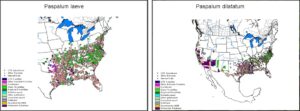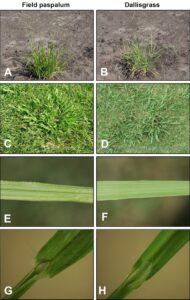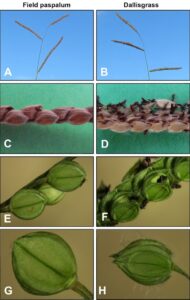Field Paspalum
Biology: Field paspalum (Paspalum laeve Michx.) is a warm-season perennial weed with short rhizomes similar to dallisgrass (Paspalum dilatatum Poir.). Much of the below Weed of the Month entry comes from research conducted in Indiana on how to control Field Paspalum. That research was published in 2012. Reicher, Z.J., A.J. Patton, and D.V. Weisenberger. 2012. Suppression of field paspalum in Kentucky bluegrass with mesotrione. [Online]. Appl. Turfgrass Sci. doi:10.1094/ATS-2012-0626-01-RS.
Identification: Field paspalum is a wide-bladed (3-10 mm wide), warm-season perennial turfgrass that becomes easily visible in mid-summer. It can have either dark green or yellow green foliage. It is found in cool-season and warm-season turf. It has a short rhizomes near the soil surface but spreads primarily by seed. Although these species have short rhizomes, they effectively are a bunch-type plant and form scattered clumps of grass in the landscape.
Field paspalum and dallisgrass can be distinguished from one another by a few characteristics although they are more similar than different. The range of adaptation is different with field paspalum distributed into farther north than dallisgrass. Field paspalum can be found in Kansas, Missouri, Illinois, Indiana, Ohio, Pennsylvania, and Maryland whereas dallisgrass is less commonly distributed in those areas (Fig. 1). Leaf sheath, leaf blades, and rhizomes of the two species are similar (Fig. 2). Both species have terminal panicles with racemosely arranged branches of similar number and length (Fig. 3). Dallisgrass can be distinguished from field paspalum by the spikelets in pairs appearing to be in four rows on dallisgrass compared to two in field paspalum (Fig. 3). Additionally, dallisgrass has long, silky hairs on the spikelets while field paspalum is glabrous (Fig. 3). Dallisgrass also has a 5- or 7-veined glume while field paspalum has a 3-nerved upper glume with veins at the margins (Fig. 3).
Cultural control: Reduce soil compaction and promote practices that increase turf density. The most effective way to control these weeds is to dig up the clumps in the turf with a shovel.
Biological control: None known.
Chemical control: Another option is spot treatment with the nonselective herbicide glyphosate (Roundup and others). At least two glyphosate applications are needed. Apply when the plant first greens up in the spring (late April or May), and again when regrowth appears. Multiple follow-up applications may be required. You can also spray dallisgrass and field paspalum in October before they turn off color and enter winter dormancy. Use a 1-2% spray solution (1.3-2.6 fl oz of glyphosate/gal of water).
Obviously, glyphosate is going to kill some of the desirable grass and could leave big, brown spots in the turf so spot apply the herbicide only to the weed and not to the turf, if possible. You can even use a paintbrush, sponge, or foam applicator to apply the glyphosate only to the weed to help reduce the risk of injuring the desirable turf.
In Kentucky bluegrass, fine fescue, tall fescue, or perennial ryegrass lawns, three applications of mesotrione (Tenacity) at 5 oz/A spaced with a two-week application interval should reduce dallisgrass and field paspalum by 75 percent or more. Start making these applications in June. In tall fescue, two applications of fluazifop (Fusilade II) at 5-6 oz/A at three- to four-week intervals starting in late-April and September will suppress field paspalum and dallisgrass. Adding triclopyr (Turflon Ester Ultra or Triclopyr 4) at 1 qt/A to fluazifop will improve turfgrass safety. Do not use on seedling tall fescue less than four weeks old.
Tribute TOTAL (thiencarbazone + foramsulfuron + halosulfuron) at 3.2 oz/A also is effective at controlling dallisgrass in bermudagrass and zoysiagrass turf when making multiple applications in later summer and early fall before winter dormancy, and a subsequent follow-up application in spring.
In zoysiagrass, two applications of fluazifop (Fusilade II) at 3-4 oz/A at three- to four-week intervals during the summer will suppress field paspalum and dallisgrass. Adding triclopyr (Turflon Ester Ultra or Triclopyr 4) at 1 qt/A to fluazifop will improve turfgrass safety.
Aaron Patton, Turfgrass Extension Specialist, Purdue University


